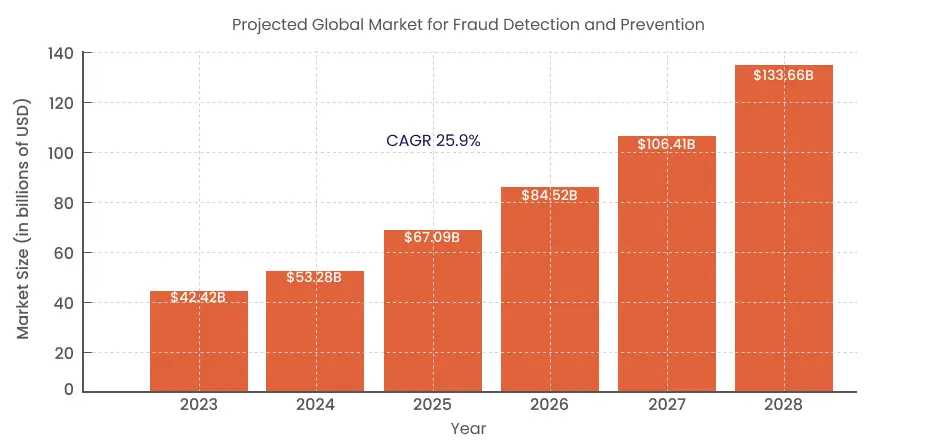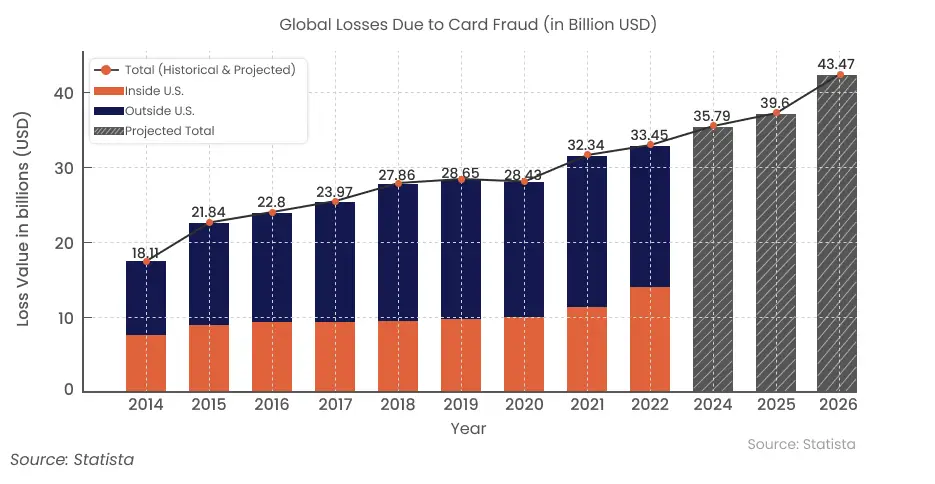Table of Contents
In 2025, the Association of Certified Fraud Examiners (ACFE) reported that global organizations suffered a loss of $3.1 billion due to fraud incidents, each resulting in an average of more than $1.5 million in financial setbacks. This concerning data highlights the requirement for anomaly detection systems across various sectors.
What is Anomaly detection?
Anomaly detection involves pinpointing data points or patterns that differ notably from the trends or standards in a given dataset. These irregularities are typically intricate and can signal potential fraud instances, system malfunctions, or other critical problems demanding prompt resolution. With the escalating volumes of data being processed, conventional detection techniques frequently struggle to spot these subtle deviations.
Generative AI in anomaly detection involves utilizing algorithms to understand typical data patterns and pinpoint irregularities with exceptional precision. Through proactive anomaly detection, generative AI enables businesses to improve their operational resilience and security measures.

Applications of Generative AI in Anomaly Detection
1. Financial Fraud Detection
In finance, spotting fraud is crucial to preventing financial losses. Generative AI in anomaly detection helps uncover patterns in vast transaction datasets, such as unusual transaction frequencies, sudden spikes in values, or geographic inconsistencies. AI models can effectively pinpoint anomalies that signal potential fraudulent activities by creating data that mirrors transaction patterns.
For instance, when it comes to credit card transactions, leveraging AI for anomaly detection allows for identifying unauthorized actions that deviate from the usual behavior, safeguarding customer money, and strengthening trust.
2. Cybersecurity Threat Detection
Cybersecurity is a field where Generative AI in anomaly detection shines brightly! Generative models like GANs are trained using network activity data to recognize traffic patterns, enabling them to alert malicious activities when deviations occur.
For instance, unusual logins or unexpected data transfers can quickly catch attention with this approach in place. This technique is vital for pinpointing zero-day exploits that lack signatures, effectively defending against and neutralizing sophisticated cyberattacks with generative AI.
3. Healthcare Diagnostics and Disease Detection
Generative AI is revolutionizing healthcare diagnostics by analyzing imaging and patient data. Studying different cases uncovers abnormalities that may indicate early signs of conditions, like tumors or irregular lab results. This method is particularly valuable for spotting diseases that might not exhibit symptoms at first glance.
A prime example is the use of AI-powered anomaly detection methods in identifying stages of Alzheimer’s disease by detecting structural brain alterations that can be missed by conventional diagnostic approaches.
4. Predictive Maintenance in Manufacturing
In manufacturing industries today, applications of Generative AI improve maintenance processes by monitoring equipment data to spot early signs of possible failures. These advanced models examine machine performance metrics like vibrations and temperatures to catch any irregularities that could signal wear and tear or malfunctions.
This proactive approach helps prevent downtimes and saves on maintenance expenses by addressing issues before they impact production. Furthermore, anomaly detection generative AI models identify changes in machinery performance that often foreshadow mechanical breakdowns.
5. Retail Loss Prevention
Retail stores utilize anomaly detection using generative AI to mitigate losses caused by theft and fraud incidents. By analyzing security camera footage and transaction records in real-time, generative AI can detect abnormal behavior patterns such as unusual activities on store cameras, inconsistencies in stock levels, or unauthorized employee access to restricted zones.
For example, when there is a decrease in inventory levels without corresponding sales data, the AI system promptly identifies this anomaly, triggering a response for investigation and implementing proactive strategies to prevent further losses.
6. Energy Consumption Monitoring and Optimization
In the energy sector, use cases of Generative AI in anomaly detection involve monitoring energy consumption patterns in grids or buildings. By analyzing trends in energy usage data points, Generative AI models can identify increases or irregular patterns in usage hours that suggest a possible fault, theft of energy, or inefficient practices.
For instance, a sudden surge in power usage during unusual times might indicate faulty machinery, prompting maintenance crews to address the issue promptly and enhance overall energy efficiency throughout the system.
7. Supply Chain Risk Management
Supply chains face risks from events that can be expensive and harmful to operations. Applications of Generative AI in the detection of supply chain anomalies involve tracking logistics information to detect abnormalities in supplier performance data, internal stock levels, and delivery timelines. Generative AI models can review data to highlight delays, differences in routes, or inconsistencies in inventory.
For example, a major change in delivery time from a supplier might signal a disruption, enabling businesses to make preemptive adjustments to reduce risks.
8. Telecommunications Network Management
Generative AI in anomaly detection plays a key role in telecommunications by ensuring network stability by identifying technical glitches that may cause service disruptions. By analyzing network data and detecting anomalies such as latency levels or unexpected bandwidth usage variations, AI models can help detect potential network failures or localized cyberattacks, enabling providers to resolve issues proactively and maintain high service quality for users.
9. Insurance Fraud Detection
The insurance industry depends on anomaly detection techniques driven by generative AI to spot fraudulent claims and avoid financial losses effectively. By examining past claim records, generative AI can pinpoint irregular claims that could signal potential fraudulence, like frequent claims originating from one specific area or typical injury trends.
For instance, a sudden surge in claims from one region may indicate an organized fraud scheme. Hence, allowing insurance companies to investigate further and minimize fraudulent payouts.
10. Quality Control in Pharmaceutical Manufacturing
Ensuring the quality of products in pharmaceutical manufacturing is crucial. Applications of Generative AI in anomaly detection support quality control by monitoring production data to identify any inconsistencies that may arise. Generative AI models analyze data from production batches. It includes details like chemical concentrations and environmental factors, to identify any anomalies that could impact the quality of the product.
For example, when a batch of drugs displays changes in composition, the anomaly detection system powered by Generative AI can pinpoint occurrences for further testing. This process effectively ensures adherence to guidelines and upholds patient safety protocols.
Benefits of Using Generative AI in Anomaly Detection
1. Improved Accuracy in Detection Systems
In traditional systems, the challenge lies in encountering false positives, where regular fluctuations get mistaken for irregularities. By using data to represent typical patterns, AI anomaly detection algorithms enhance precision. These algorithms identify discrepancies, enabling teams to focus on genuine anomalies and improving the overall reliability of detection.
2. Early Warning and Predictive Insights
Generative AI models can spot gradual changes and trends in advance, which can serve as a warning for problems ahead of time. This feature is particularly useful in areas such as maintenance, where detecting slight indications of machinery wear and tear early on can help avoid expensive breakdowns and offer organizations crucial time to tackle problems proactively.
3. Reduced False Positives
Traditional systems often struggle with producing false alerts, which can drain resources significantly—a limitation indeed! However, AI-based anomaly detection takes advantage of deep learning to enhance its understanding of patterns and effectively minimize false alarms. This allows teams to allocate their resources efficiently and avoid getting overwhelmed by alerts.
4. Cost Efficiency in Data Collection and Training
Generating data using AI helps reduce the reliance solely upon extensive real-world data that can be both expensive and time-consuming to collect. This method is particularly advantageous when it comes to tasks like anomaly detection, as it ensures that models are trained efficiently without the process of collecting large amounts of labeled data.
5. Improved Security and Privacy
In industries where privacy is crucial, such as healthcare and finance, AI anomaly detection algorithms can significantly enhance security measures. Generative AI produces datasets replicating real data without exposing private details, thus enabling effective anomaly detection methods while safeguarding data confidentiality.
Challenges and Limitations
- Data Quality and Availability: Obtaining unbiased and sufficient data can be complex. Inadequate data can lead to errors in AI-based anomaly detection, which challenges generative AI models to function effectively and accurately and detect anomalies based on genuine patterns.
- Computational Complexity: Complex tasks require high computing power, hardware, and expertise. Access and implementation can be challenging for certain organizations.
- Understanding How AI Models Work: When it comes to AI models, interpretability issues arise as they sometimes act like “black boxes,” making it challenging to articulate the reasons behind their outcomes. It is particularly significant in sectors such as healthcare and finance, where providing clear rationales is crucial to decision-making.
- Risk of Overfitting: The issue with overfitting is that generative models may excel with the data they were trained on but face challenges when dealing with new data sources. This leads to a decrease in detection precision.
- Ethical and Privacy Concerns: AI for anomaly detection presents privacy challenges, as confidential data is involved. Organizations must adhere to regulations and prevent any misuse of AI-generated findings.
To overcome these challenges, it’s essential to work with a trusted Generative AI development company equipped to handle the intricacies of AI integration.

How to Implement Generative AI in Anomaly Detection?
Implementing Generative AI applications for anomaly detection requires an intricate process to effectively identify unusual patterns in different fields. Step-by-step process:
1. Define Objectives and Scope
- Detecting Anomalies: Recognize types of anomalies for detection purposes, such as financial misconduct or irregularities in equipment functioning and potential cybersecurity risks, for a more focused approach suited to the unique challenges within the field.
- Set Measurement Standards: Define success benchmarks by setting standards such as accuracy in detection results and rates of positives and negatives. It also include metrics such as precision, recall, and response times to assess and enhance the model.
2. Data Collection and Preprocessing
- Gather Relevant Data: Collect extensive datasets encompassing normal and abnormal behaviors. In domains like AI in fraud detection, this includes transaction histories, user behaviors, and known fraud cases.
- Data Cleaning: To improve data quality, solve irregularities by filling in missing data points and properly identifying and handling outliers.
- Feature Engineering involves Identifying and constructing features that effectively represent the underlying patterns in the data. This may include creating new variables or transforming existing ones better to capture the nuances of normal and abnormal behaviors.
3. Select Appropriate Generative AI Models
- Autoencoders are designed to understand and recreate input information, allowing them to detect anomalies by assessing reconstruction errors. Significant errors indicate deviations from what’s considered standard.
- Variational Autoencoders (VAEs) are used to understand complex data patterns and create new data points. They play a key role in anomaly detection by pinpointing data points that do not conform to the learned distribution.
- Generative Adversarial Networks (GANs) involve a generator alongside a discriminator network. It creates synthetic data, and the discriminator checks its legitimacy and accuracy.
4. Model Training
- Train on Normal Data: Train the model using datasets representing typical behavior. This helps the model learn the standard patterns and variations within the data.
- Validation: Testing the model using established anomaly datasets to determine how well it detects anomalies. This is important for assessing its generalization ability to unseen data.
- Hyperparameter Tuning: Modify model settings like learning rates and batch sizes as network structures to enhance performance metrics effectively by utilizing methods such as grid search or random search.
5. Deployment and Monitoring
- Integrate with Existing Systems: Make sure the model smoothly integrates with the current workflows to enable real-time detection of anomalies and quick response when needed.
- Real-Time Monitoring: Track data streams and identify any irregularities as they arise, allowing for investigation and resolution of possible issues.
- Continuous Learning: Update the model with new data to adjust to emerging trends and irregularities. This includes retraining the model periodically or utilizing online learning methods.
6. Evaluation and Refinement
- Performance Assessment: Regularly assess the model’s performance by checking its accuracy, precision, and recall metrics to ensure it meets the performance standards.
- Feedback Loop: Refining the model’s detection capabilities involves taking feedback from experts in the field and end users to minimize false positives and negatives.
- Scalability Considerations: Ensure the model can manage large amounts of data and more tasks without losing speed or efficiency. This includes optimizing algorithms or scaling computational resources.
Future Trends of Generative AI in Anomaly Detection
Research and technological progressions are promising in the field of Generative AI in anomaly detection. One exciting innovation involves combining Generative Adversarial Networks (GANs) with anomaly detection setups, where GANs generate data that closely resembles real-world patterns.
This function allows for developing data sets to train anomaly detection models better and improve their capacity to detect deviations effectively. For example, in real-world applications of anomaly detection in cybersecurity, GAN can simulate various attack situations to help systems recognize and address new threats more precisely.
Another new trend gaining traction involves using Generative AI for predictive maintenance in various sectors like manufacturing and energy production. This analyzes data from machinery sensors to predict breakdowns in advance and enable maintenance to prevent downtime. This proactive strategy enhances efficiency and prolongs the lifespan of equipment.
How A3Logics Can Help You in Developing Generative AI solutions as per your needs?
A3Logics offers specialized services to help businesses implement and benefit from generative AI across industries. As a Generative AI consulting company, A3Logics provides end-to-end support, from assessing your organization’s specific needs to designing customized AI solutions tailored for anomaly detection, predictive analytics, and beyond.
Whether you’re in finance, healthcare, manufacturing, or cybersecurity, A3Logics brings deep expertise and industry knowledge to ensure that AI-driven strategies align with your operational goals and regulatory requirements.
A3Logics offers the opportunity to hire generative AI engineers with advanced skills and experience. These engineers are proficient in building, training, and optimizing generative AI models. The AI models are tailored to industry-specific challenges, from fraud detection to quality control.
By partnering with A3Logics, organizations can swiftly integrate generative AI solutions into their technology stacks and benefit from ongoing support as their AI initiatives grow.
Conclusion
Generative AI is transforming anomaly detection by enabling businesses to detect subtle, complex patterns that traditional methods often overlook. By learning normal behavior patterns and flagging deviations with precision, it has proven value across sectors like finance, healthcare, manufacturing, and cybersecurity. As this technology continues to advance, it will only become more integral in safeguarding operations, optimizing processes, and reducing risk.
Partnering with a reputable AI development company can provide businesses with the expertise and resources needed to implement these advanced systems effectively.
FAQs
How is AI used in anomaly detection?
AI detects anomalies by analyzing data patterns and flagging deviations from the norm. Therefore, it identifies potential issues like fraud, system failures, or security threats.
How is AI-based anomaly detection better than traditional methods?
AI-based anomaly detection is more adaptive and accurate. Hence, it continuously learns and refines its understanding of “normal” data, which reduces false positives compared to rule-based traditional methods.
What types of AI models are used for anomaly detection?
Common AI models include Autoencoders, GANs, and VAEs. Each with strengths in detecting various anomaly types across supervised, unsupervised, and generative approaches.
How is anomaly detection used in cybersecurity?
Anomaly detection flags unusual activities in network traffic and login attempts in real-time. Therefore, it helps prevent data breaches and unauthorized access in cybersecurity.
What are generative models for anomaly detection?
Generative models, like GANs and VAEs, create synthetic data to define normal patterns. This enables them to detect deviations effectively, including subtle or previously unknown anomalies.








